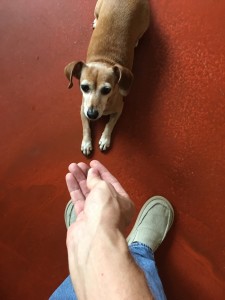Michael Baugh CPDT-KSA, CDBC
 The question isn’t whether or not you can train your dog with food. That’s pretty much a no-brainer. Author and long-time animal trainer Dr. Grey Stafford put it best. “If you’ve ever fed your dog, you’ve trained with food.” Dogs have learned to do all sorts of things for their food bowl, including beg, spin in circles and jump on people. What seems strange is that so many people would sooner give their dog a bowl of food for all that annoying behavior, than use small bits of food to teach desired behavior. There seems to be a disconnect. Feeding is good. Food in training is bad. Even some self-professed trainers advertise that they don’t use food in training. Why? Dr. Stafford inspired the title of this article when he made the claim that should be common sense to all of us. Food is not a four-letter word.
The question isn’t whether or not you can train your dog with food. That’s pretty much a no-brainer. Author and long-time animal trainer Dr. Grey Stafford put it best. “If you’ve ever fed your dog, you’ve trained with food.” Dogs have learned to do all sorts of things for their food bowl, including beg, spin in circles and jump on people. What seems strange is that so many people would sooner give their dog a bowl of food for all that annoying behavior, than use small bits of food to teach desired behavior. There seems to be a disconnect. Feeding is good. Food in training is bad. Even some self-professed trainers advertise that they don’t use food in training. Why? Dr. Stafford inspired the title of this article when he made the claim that should be common sense to all of us. Food is not a four-letter word.
Here’s how positive reinforcement training works. If your dog spins in circles and barks, and the result is that you give him a heaping bowl of food, then he’s going to do more spinning and barking in the future. It’s that simple. Our dogs will keep doing the stuff we pay for. In fact, it’s science (See “The Science of Dog Training”). Dr. Susan Friedman PhD is a behavior analyst. She cuts right to the meat of the matter. “If behavior has no effect, what are we behaving for?” So why not use the effect to our advantage? Dog sits – food – more sitting. Dog comes when called – food – more coming when called. The list goes on.
Do you always have to have food with you? No. But (there’s always a “but”), it doesn’t hurt. As your dog learns good manners, he may only get food every once in a while. Many trainers refer to that as “phasing out the food.” Use food to show your dog how to do new things (trainers call it luring), but don’t get stuck in a long-term pattern of bribing. You should put the food out of sight as soon as possible. Keep it handy but hidden. Dr. Stafford speaks from experience, “I’ve trained hundreds of animals covering more species than I can recall. The one lesson I’ve learned is the ultimate power of positive reinforcement, whether you train dogs or dolphins, is in its unpredictability.” That means your dog will get paid for doing things you like, but not always how and when he expects it. Any dog knows to come running when you’re wearing a treat bag, but try sneaking a few treats in your pocket, and then call your dog while you’re brushing your teeth or watering the lawn. He’ll be mighty surprised when you hand him that food for a job well done. Now, that’s unpredictability.
Is food the only way you can reinforce your dog’s behavior? No. But, some of the most potent reinforcers speak directly to the animal’s biological needs. We call those primary reinforcers, and they include food, shelter, reproduction, and control (the ability to make choices). In dog training food just happens to be the easiest primary reinforcer to deliver. For professional trainers, food is often a first choice when teaching simple behaviors because you can get a lot more repetitions. Modern trainers pair the food with praise and smiles. Those are called secondary reinforcers. In time, praise, smiles, etc. will take on some of the built-in value of the food. That’s a good thing. You’ll want lots of possible reinforcers in your training tool kit.
What will your dog work for? Some dogs love food. But, other dogs will work for the chance to fetch a ball, play tug, or cuddle on the sofa. Still other dogs learn to love petting and praise. Dr. Friedman notes, “It’s a teacher’s job to notice that individuality and use it well. The more reinforcers a learner has the more enriched its life can be.” It’s our job to find what motivates our dog and to then use that to get the behaviors we want. Pay your dog for doing great things in lots of different ways, and see how that adds to the excitement from the dog we are looking for. Your dog will work harder and learn faster because he’s always wondering, what am I going to get this time?
Is training all about the food? No, and there’s no “but” about it. Using food, pairing it with praise and fun, teaching your dog what pays and what doesn’t – that’s all about your discovering how to better communicate with your dog. It’s about learning new things, looking for the next task, and loving every minute of it together.
